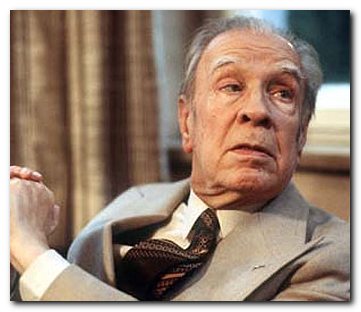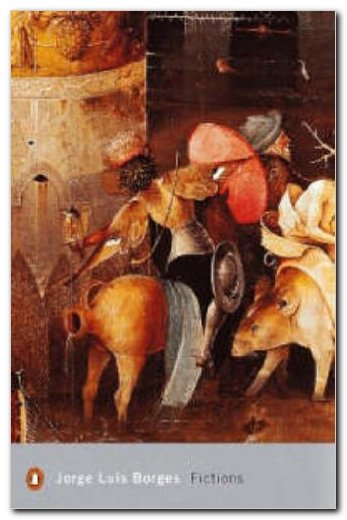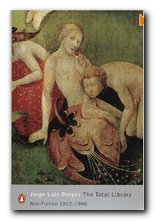short stories, satirical sketches, and parodies of criticism
Chronicles of Bustos Domecq (1979) is a collection of short fiction that Jorge Luis Borges wrote in collaboration with his fellow Argentinean, the novelist Adolfo Bioy Casares. Both of them wrote stories, reviews, and skits for a variety of newspapers and literary journals – particularly Sur, founded by their friend Victoria Ocampo in 1931.
Their stories explore the playful, imaginative, and sometimes fantastic relationship between fiction and reality which Borges was to make his hallmark in works such as the famous collection of stories Fictions. His collaborator Casares was a writer, journalist, and translator best known for his science fiction novel The Invention of Morel

Honorio Bustos Domecq was an Argentinean man of letters. A brief note on Domecq written by Dr Gervasio Montenegro (Argentine Academy of Letters) acts as an introduction and preface to the stories. This preface itself arouses our suspicions, for it is written in an absurdly inflated and self-regarding manner. Montenegro showers praise on his own achievements as a writer, and damns the work of Domecq with praise so faint it is almost insulting. It is no surprise to learn that both Domecq and Montenegro are entirely fictitious.
Homage to Cesar Paladion is a biographical sketch of the Argentinean writer whose ‘poetical method’ was inspired by the fact that T.S.Eliot and Ezra Pound quoted from Baudelaire, Verlaine, and The Odyssey in their work. Paladion took this approach one step further by ‘appropriating’ entire works from other writers. He had books such as The Hound of the Baskervilles and Uncle Tom’s Cabin printed under his own name and at his own expense.
In another story a newspaper reporter goes to interview Ramon Bonavena, the author of a six-volume masterwork called North-Northwest. When asked to give an account of the work’s genesis for his admiring readers, Bonavena explains that he set out with the idea of a large scale historical drama exposing social injustices in the province where he lived. However, when faced with legal difficulties, he decided to limit his subject matter – and chose to write about the objects on the right-hand corner of his desk.
The skill in the telling of these stories lies in a combination of conceptual manipulation, structural artifice, and stylistic flair. The credibility of the essential concept behind each story is established by reference to real places and real people. This material is then blended with quite credible life histories that are actually fictitious.
The absurdity of each proposition is usually concealed until the story is well under way – by which time the reader is prepared to entertain it as acceptable. And once the absurdity is revealed, the story is short enough to prevent the conceit becoming tedious.
A study of the poetical works of F.J.C.Loomis traces the development of his publications from his breakthrough Bear in 1911, through Pallet, Beret, Scum, Moon, and Perhaps? which was published posthumously following his death from dysentery in 1931. Bustos Domecq explains that Loomis’s particular genius was for an exact match between the title of his works and their contents. He points out that “The words Uncle Tom’s Cabin do not readily communicate to us all the details of its plot.” In the case of Loomis all the common poetical trappings of metaphor, symbol, rhythm, and alliteration are stripped away to create an exact match between title and content – because each text consists of just the single word of its title.
G.A.Baralt is an Argentinean attorney who has written a multi-volume study of the Brotherhood Movement. This movement is based on the observation that at any given time, all over the world, some people will be doing exactly the same thing. This could be anything from getting out of bed to striking a match. At the conclusion of the story Baralt is compiling, as a supplement to the main study – a list of all possible Brotherhoods, including those who thought about a particular topic two minutes ago, or those who three minutes ago forgot about it.
Some of the stories are amazingly prophetic, given some of the more absurd ‘developments’ in modern art in recent decades. The tales deal with what we would now call ‘happenings’ (random gatherings of people) uninhabitable architecture, ‘concave’ sculpture (composed from the space between objects) and the work of an ‘abstract’ artist all of whose canvases are covered in black shoe polish.
Bustos Domecq emerges as a comic figure in his own right from the stories he relates. As an occupational sideline he sells tickets for events that don’t take place, orders drinks he doesn’t pay for, and publishes (strictly by subscription in advance) the work of a worthless poet. He is pompous, self-regarding, and his literary style is amusing in itself – filled with creaking and orotund journalese, recent archaisms, irrelevances, and non-sequiturs.
The weaker examples of this collection lapse into silliness and mere whimsy, but the basic approach is quite subtle – given that the stories contain amusingly absurd ideas and are related by not only an unreliable narrator but one with an off-beat, almost bizarre literary style.
© Roy Johnson 2015
Jorge Luis Borges, Chronicles of Bustos Domecq, New York: E.P.Dutton, 1979, pp.143. ISBN: 0525080473
Jorge Louis Borges links
![]() Borges Center – University of Pittsburgh
Borges Center – University of Pittsburgh
More on Jorge Luis Borges
Twentieth century literature
More on study skills

 From his earliest years he produced book reviews, essays, lectures, film reviews, prologues, and translations in addition to his now-famous fictions. He even invented literary genres – the essay which is part philosophic reflection and part fiction; studies of imaginary works; and biographies of people who did not exist. This in addition to spoofs, mind games, and metaphysical writings of a kind that seem to transcend national boundaries – which is partly why he managed to establish his international reputation.
From his earliest years he produced book reviews, essays, lectures, film reviews, prologues, and translations in addition to his now-famous fictions. He even invented literary genres – the essay which is part philosophic reflection and part fiction; studies of imaginary works; and biographies of people who did not exist. This in addition to spoofs, mind games, and metaphysical writings of a kind that seem to transcend national boundaries – which is partly why he managed to establish his international reputation.